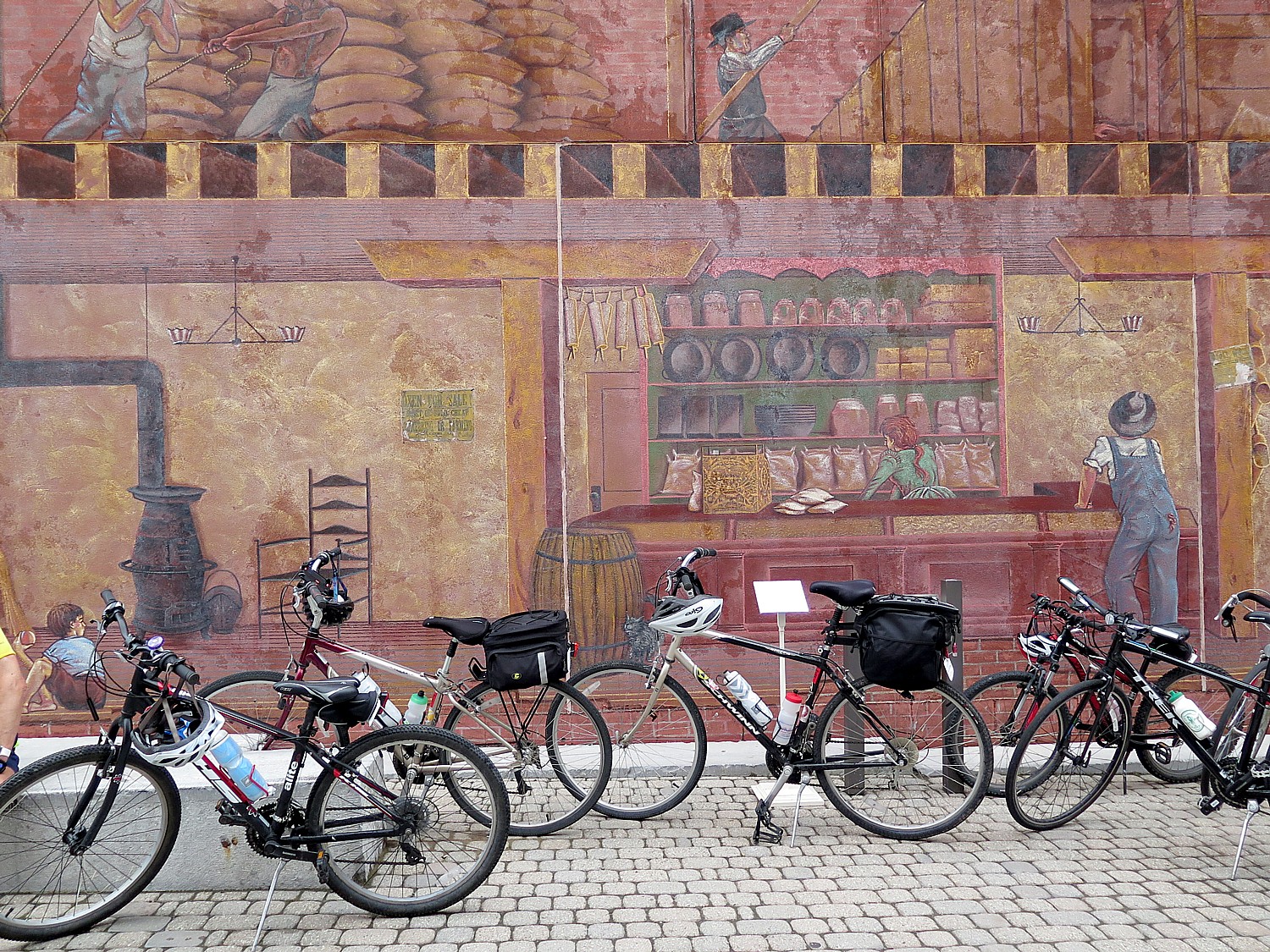
By Karen Rubin, Travel Features Syndicate, goingplacesfarandnear.com
Day 5: Syracuse to Rome, 50 Miles
Day 5 of our 8-day, 400 mile Cycle the Erie biketour from Buffalo to Albany offers a deep-dive into the history of the Erie Canal, an appreciation for the engineering marvel that it was, and how it changed American culture and society, as our 50-mile ride today brings us to a sequence of museums and historic sites.
We begin the day riding into downtown Syracuse from our campsite at Burnet Park, adjacent to the Rosamond Gifford Zoo (we are so close, some said they could hear the animals during the night). A highlight for the entire trip is visiting the Syracuse Eric Canal Museum, which has opened early, from 7 am, especially for us. It is not to be missed and I plan to spend a couple of hours here. (The museum also was open especially for us last evening, with shuttle bus transportation from our campsite, to accommodate our riders, but I chose to visit the zoo.)
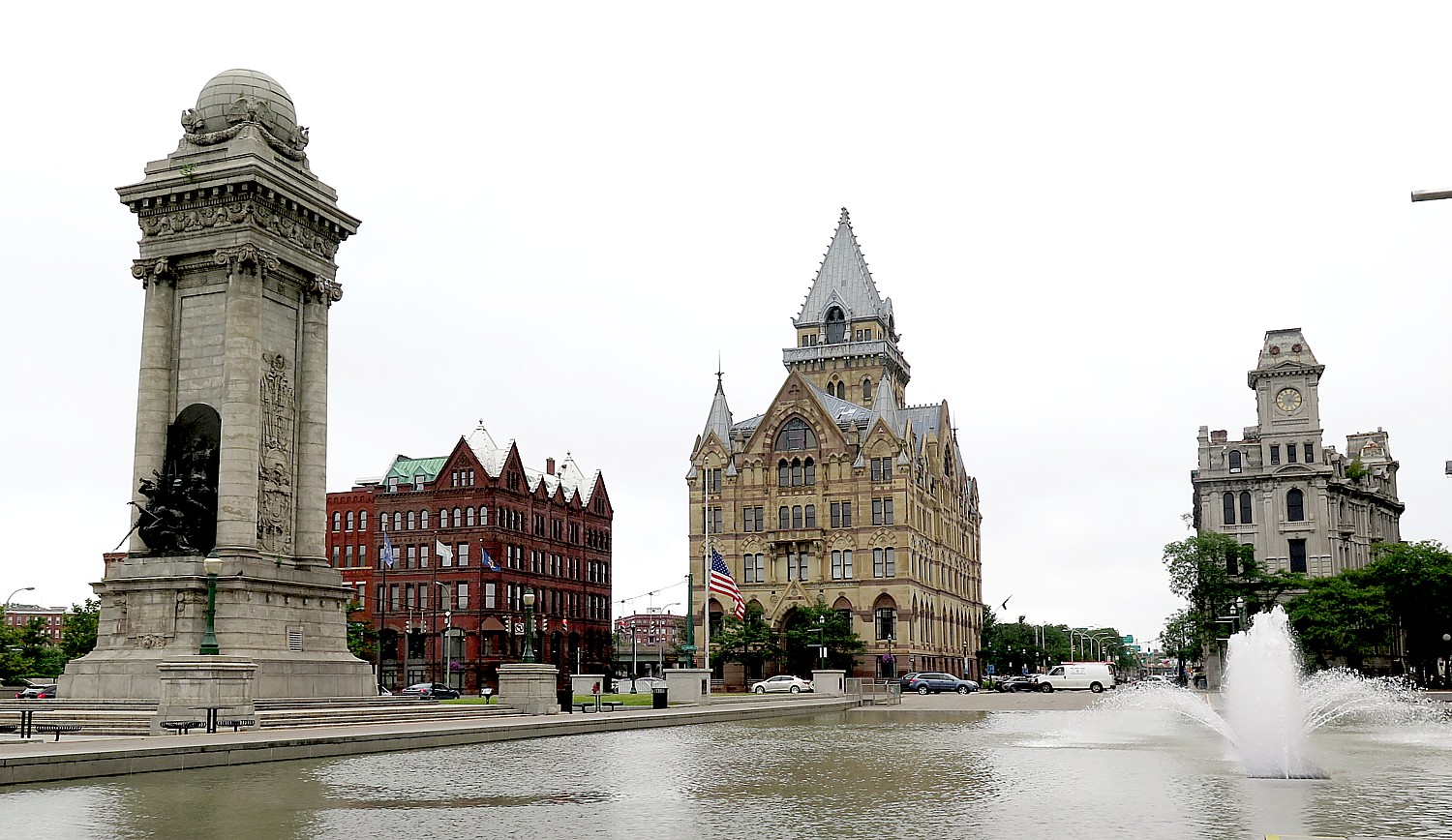
The downtown of Syracuse has gone through an amazing renaissance.
Erie Canal at one time went through Syracuse but President Roosevelt wanted a “modern” canal built and largely replaced the original canal.
Today, in a magnificent plaza there is an impressive Jerry Rescue Monument to William “Jerry” Henry, a freemason taken into custody under Fugitive Slave Act, despite the fact that New York State abolished slavery in 1820.
Daniel Webster, who was secretary of state under President Millard Filmore, came to Syracuse in1851 and declared that Syracuse (which was a stop on the Underground Railroad) was “a laboratory of abolitionism, libel, and treason” and warning local abolitionists and abetting slaves that any violation of the Fugitive Slave Law, which called for returning those in flight into bondage, would be “treason, treason and nothing else.”
A few months later, on October 1, a mob stormed a downtown police station, knocked down the doors and freed Jerry, and put him on a carriage traveling toward Canada.
Syracuse Canal Museum
All along our Cycle the Erie route – mostly following the 353-mile long Erie Canalway – we have visited small canal museums and historical societies which each tell a part of the Erie Canal epic drama. At Lockport, which is itself a living-history museum, on the first day of our ride, we saw the astonishing “Flight of Five” locks and its small museum. At Camillus, the half-way mark of our 400-mile ride from Buffalo to Albany, we visited Sims Store, a re-creation of a 19th century general store that would have served the boats traveling along the canal. Still to come (later today), the Chittenango Landing Boat Museum which offers a look at how the canal boats were built and we get to look inside a reconstruction; Canastota, which offers a delightful Canal Town Museum in a tiny house that was once a bakery. Further on, we will see the Schoharie Crossing State Historic Site, featuring sections of all three alignments of the Erie Canal and a fascinating historic exhibit in a house-turned-museum.

But Syracuse is the “official” Erie Canal Museum – it offers the most expansive collection of artifacts, the most comprehensive history, starting the story well before Governor Dewitt Clinton pushed so obsessively for his Ditch. It offers the most sophisticated presentations, including lots of interactive exhibits and opportunities to engage. It is all the more remarkable because it is a maritime museum which is not on the water – indeed, the expanded canal was moved north of the city.
One of the unique features of the Canal Museum – indeed, the “most unique thing about Syracuse” – is the chance to visit the Weighlock Building, built in1850 – the only remaining weighlock building in America. You can walk aboard a replica passenger packet boat in the weighlock and get a real impression of how the Erie Canal transformed culture and society in America.
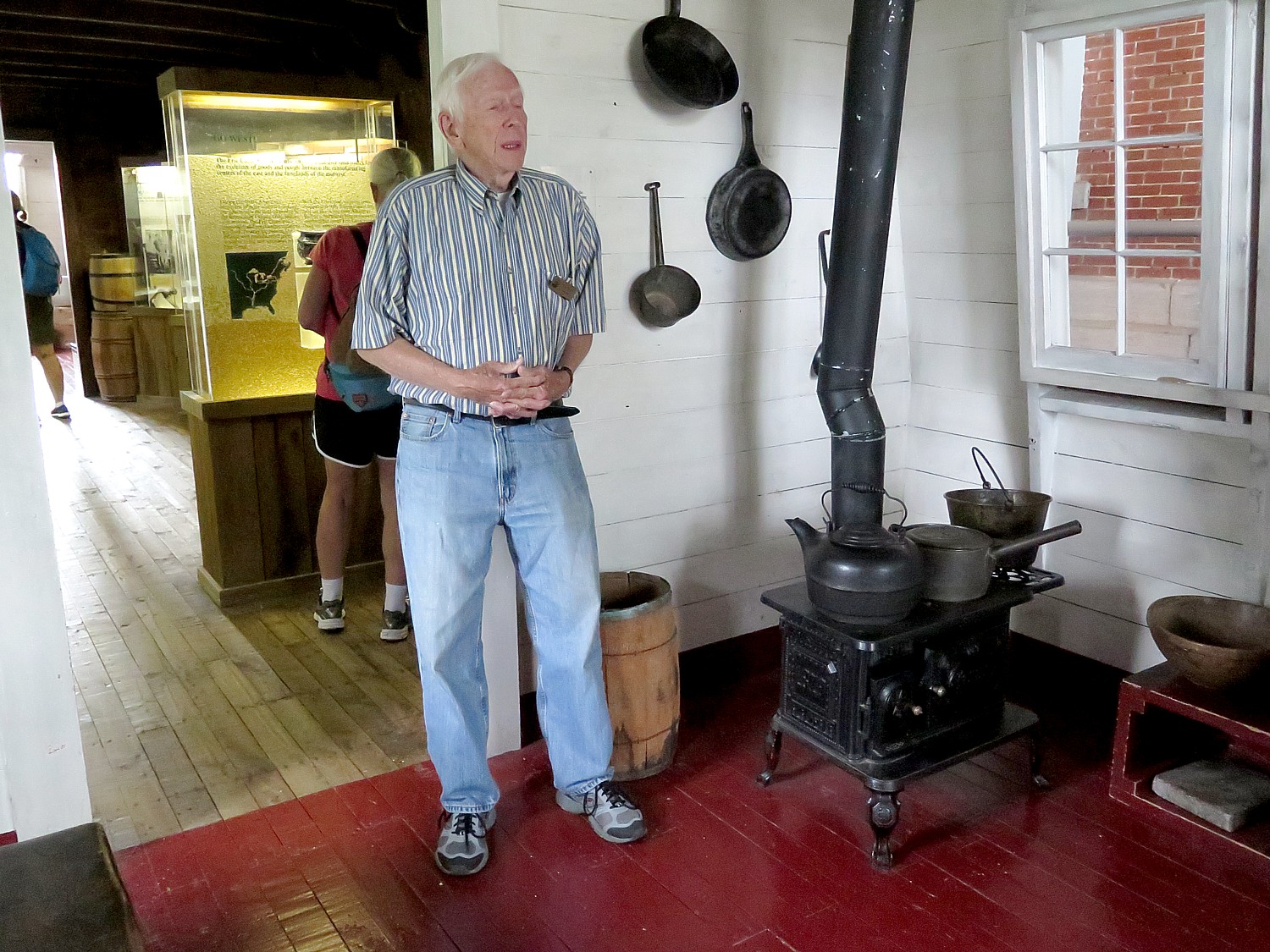
And, as we ride into the downtown historic district, with some magnificent architectural jewels (like the Niagara-Mohawk building, an Art Deco palace that is simply breathtaking), what we appreciate most is how the Erie Canal was the “Mother of Cities” – as historian Ben Willis has said – and how Syracuse is one of her children.
A chart in the museum graphs the explosive growth in population of Albany, Syracuse, Buffalo, and even small canaltowns like Lockport because of the Erie Canal, “It was the 8th Wonder of the World, the pathway to an empire, and a school of engineering.”
Indeed, in 1820, Syracuse was but a swampy settlement on Genesee Turnpike, its primary industry was salt production (a key reason that banks had already established themselves in Syracuse, before the canal). Because of the canal (“The Mother of Cities”) the population of Syracuse swelled 40-fold in just 10 years, from 250 in 1820, to 11,064 in 1830, and by 1920, a city of 171,717.
“German masons who came for the canal, stayed to build cobblestone houses, churches. The canal was a whole way of life.”
Before the Canal, it would take 6 to 8 weeks for a mule to carry less than a ton, versus 6 to8 days to transport up to 200 tons of freight on the canal. The cost dropped to one-tenth, $12 per ton and 60c for barrel of salt.
Each day, some 1,800 immigrants would come through Syracuse on the Erie Canal on their way to the west, paying 10c to travel from one town to the next.
“Land was free, you just had to get there, settle on it for a number of years. Often pioneers would work on the boat in exchange for transportation,” the notes read.
New York State financed the building of the Erie Canal (without any federal help) by selling $7.7 million in bonds; the state earned back revenue from fees on goods shipped and taxes on salt (because salt was brought out of salt springs that were owned by the state).
The success of Clinton’s Ditch was quickly apparent and in just 10 years (after paying off the $7.7 million), the Erie Canal had to be rebuilt and expanded to handle all the traffic.
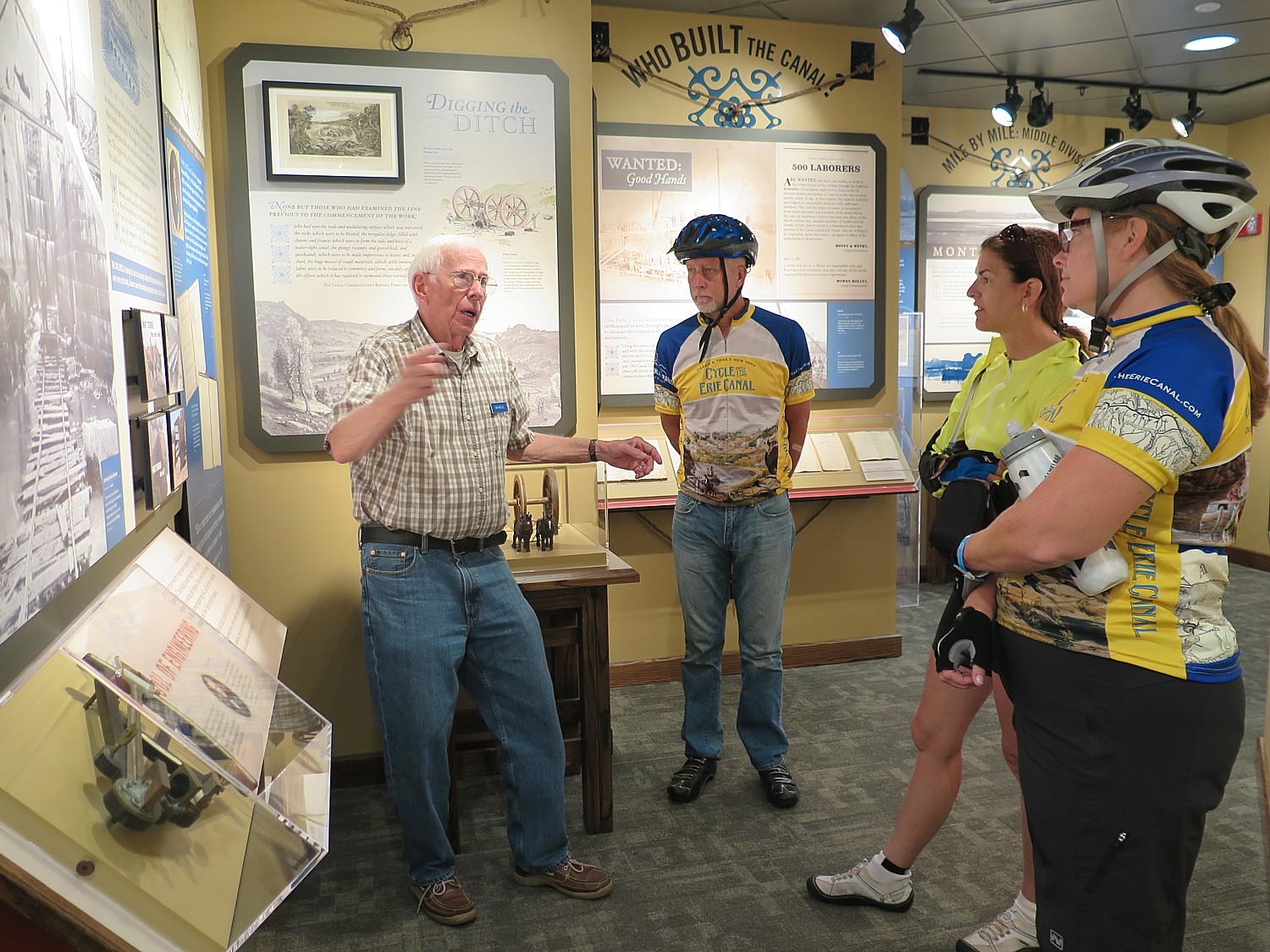
There were no real engineers when they began to build the canal. The initial designers were surveyors. “They knew how to do property lines but were not engineers.” The biggest problem was figuring out the elevations. But when they completed the canal, these self-taught engineers started the engineering school, Rensselaer Polytechnic Institute (RPI) in Troy.
One of the innovative methods devised was a stump puller to clear the trees – a contraption that looks like a military armament, but actually had giant wheels to move it and give leverage to pull out stumps.
There is so much that is so engaging in the museum – even the staircases are made so you can see the elevations of the different locks along the entire canal, and the elevator is painted so you feel you are stepping into a lock, yourself.
Indeed, a key message you come away with from the Erie Canal Museum, is how the canal keeps reinventing itself, and with it, the society around it.
Peak use of the Erie Canal was 1951, but it was also a time when the canal was fetid with pollution – oil slicks and raw sewage. Then the Clean Water Act of 1972, prohibiting dumping and requiring municipalities to have treatment plants, changed the way shippers and factories could do business. (My suspicion is that environmental protection and worker protections, not free trade, is what led to the demise of American manufacturing.)
So, up until the 1980s, the canal was almost exclusively for commercial traffic and was too polluted, fetid and crowded for the recreational boater, or, in fact, residential buildings anywhere near the canal. That’s all changed. Now, the canal is predominantly used for recreational purposes, there are lovely housing developments along the canal. But a changing upstate economy is seeing a resurgence of manufacturing and more commercial shipping is coming to the canal.
There are many other uses of the Erie Canal other than shipping and transportation. The canal is the largest source of irrigation for upstate agriculture. People don’t think of New York as agricultural, but it rivals other states, producing a range of foodstuffs – orchards, vineyards, dairy operations. Riding along the canal trail, you see the white pipes of the irrigation system. The canal also provides for flood control for upstate New York. Many of the dams generate electricity.
Here, I appreciate the ecology of the Erie Canal – not just for the people whose towns, livelihoods and lives revolved around the canal, but how it impacted the environment.

And you can see the social ecology as well – as the canal is cleaned up, there are new housing developments that are popping up alongside, as we saw at Rochester, Spencerport, Fairport, changing the economic base for these communities. (They are not intrusive, though – indeed, the entire Barge Canal was just placed on the National Register of Historic Places and is part of New York State’s Heritage Corridor). The small canaltowns are reinventing themselves – and the structures that had been factories and silos and such in places like Pittsford and Cohoes have been re-purposed for condos and offices, as well as to cater to new manufacturing ventures like manufacturing wind turbines.
“Everything reinvents itself – just like the Canal,” says Daniel Ward, who curated the exhibit. “When I was boy, there was no accommodation for pleasure craft, no tie ups. It was a barge canal. Now there is balance.
“Often the Erie Canal gets separated in people’s minds from the Port of New York, but New York City is the terminal port of the canal system. Our current work is trying to reconnect idea of New York City – we’re coming up to the bicentennial of the opening of the canal (2025), which was a celebration in New York Harbor.”
The museum has a marvelous animated display of Governor Dewitt Clinton sailing into New York City to spill water from Lake Erie into the Hudson River in a ceremony called, “The Wedding of the Waters” with simulated fireworks. (There were cannons set up all along the route and it took hours for the sound that started in Buffalo to make its way to New York City.)
He points to the Mount Vernon Museum, at 421 East 61st Street, which was a hotel that opened in the 1820s to accommodate visitors who wanted to travel on the Erie Canal on packet boats.
Before the Erie Canal, “New York City was an insignificant port city, dwarfed by Boston and Philadelphia, and became a great city, as a result of this engineering.”
What I come away with: It wasn’t that people were different in 1817 when construction of the Erie Canal began, that they had more guts, gumption, daring, pioneering spirit. If anything, what this journey back in time shows is that people are exactly the same – Governor DeWitt Clinton was mocked for the project, which was called “Clinton’s Folly” and “Clinton’s Ditch”; President James Madison refused to give federal funding, questioning the role of the federal government.
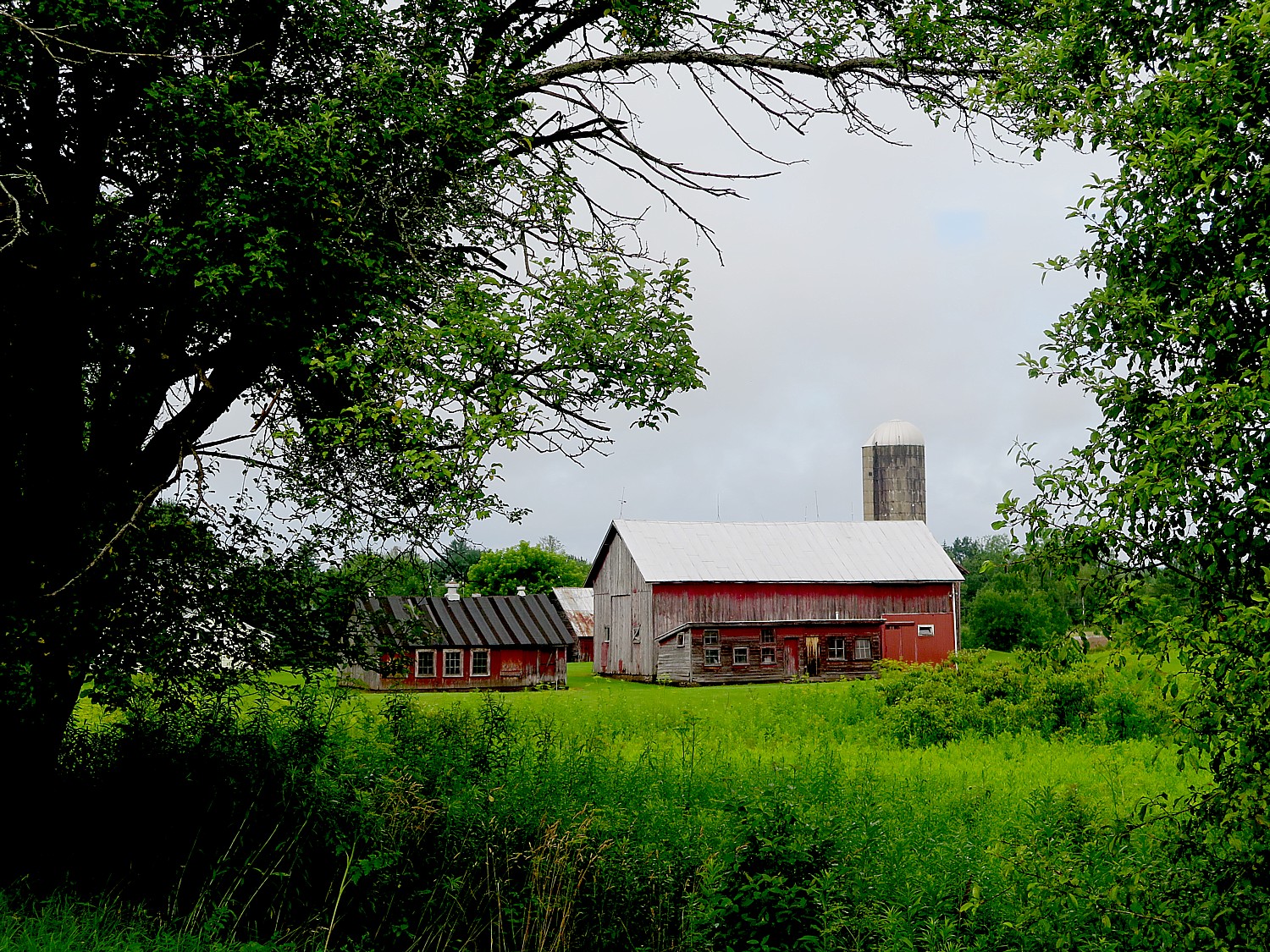
“Farmers didn’t want to give right of way,” Ward tells me, “they didn’t envision a global economy. It turned out to be great for them. They went from local subsistence economy to global. When the Erie Canal was built, it was the wave of future.”
So many morals to be drawn to today.
You can easily spend two to three hours at the Erie Canal Museum, which I happily do, even with 50 more miles to travel today.
(Erie Canal Museum, 318 Erie Boulevard East, Syracuse, NY 13202, 315.471.0593, eriecanalmuseum.org.)
Chittenango to Canastota
My deep dive into the Erie Canal’s history continues on this day’s ride.
I am fairly amazed to find some of the cyclists still at the morning rest stop when I arrive at Chittenango Landing Boat Museum, which, through preservation, reproduction, construction, and interpretation of the Chittenango Landing industrial complex, instructs about the construction and repair of canal boats and the social history of the Erie Canal era. There are people in period dress and it looks like a historic village. Here, I get to poke inside a re-creation of a canalboat, and see where the mules would have been housed on the boat with the family. (7010 Lakeport Rd, Chittenango, NY 13037, 315-687-3801, clcbm.org/)
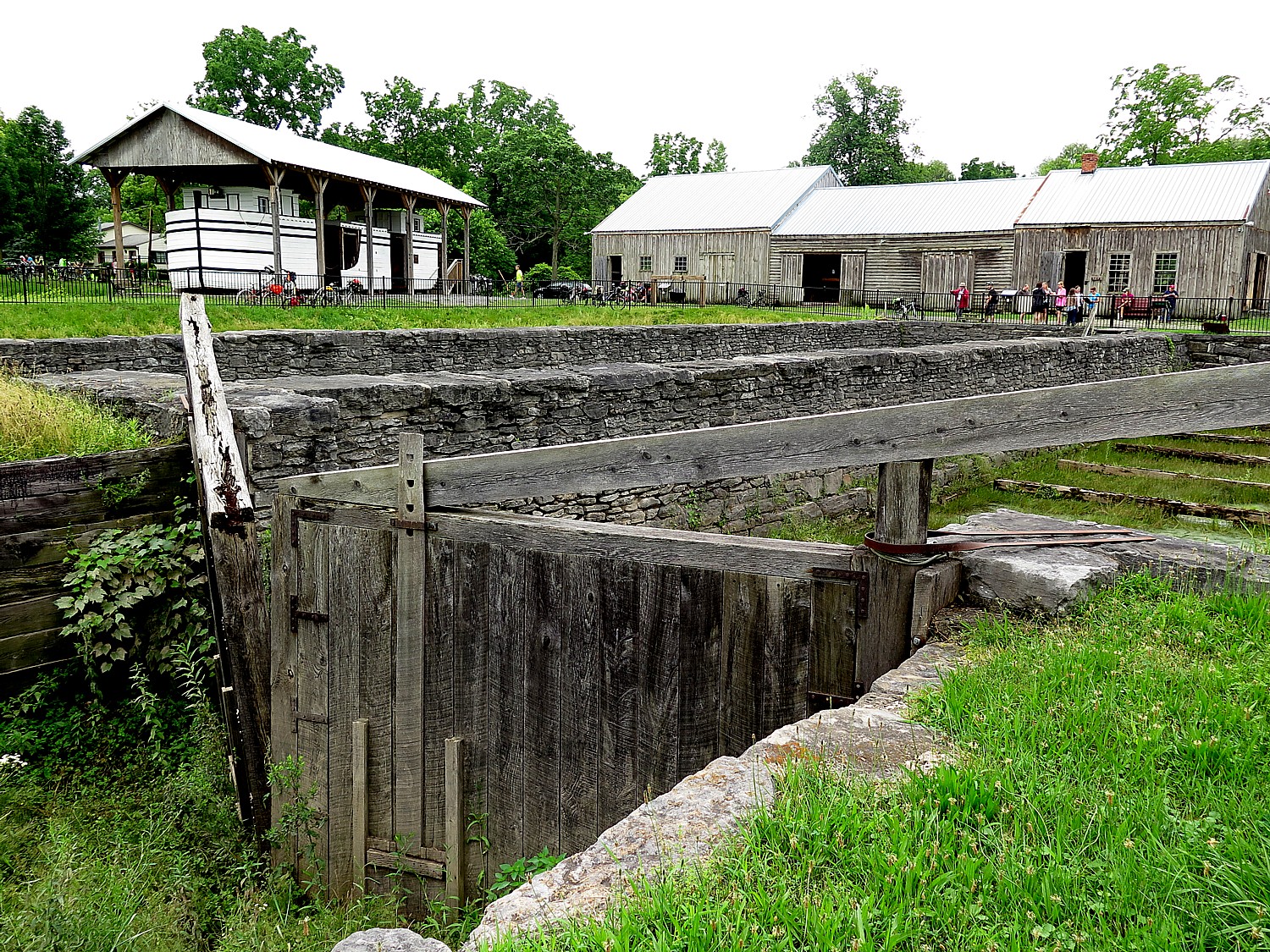
Chittenango is also the birthplace of L. Frank Blum who wrote “Wizard of Oz” (his mother-in-law was the mother of the Women’s Rights movement, Melinda Gates), and I am told the village has a yellow-brick road.
Once again, I am determined not to miss the things that I missed on my first Cycle the Erie ride two years before. I ride up the main street looking for evidence of Frank Blum – I find the yellow brick sidewalk, but before I can get to the All Things Oz Museum, which has family photos, early posters from musicals and movies before the 1939 MGM film, collectibles, it starts to rain. (Open year-round or by appointment, 219 Genesee St., Chittenango, NY 13037, 315-687-7772, allthingsoz.org).
And rain. And rain.
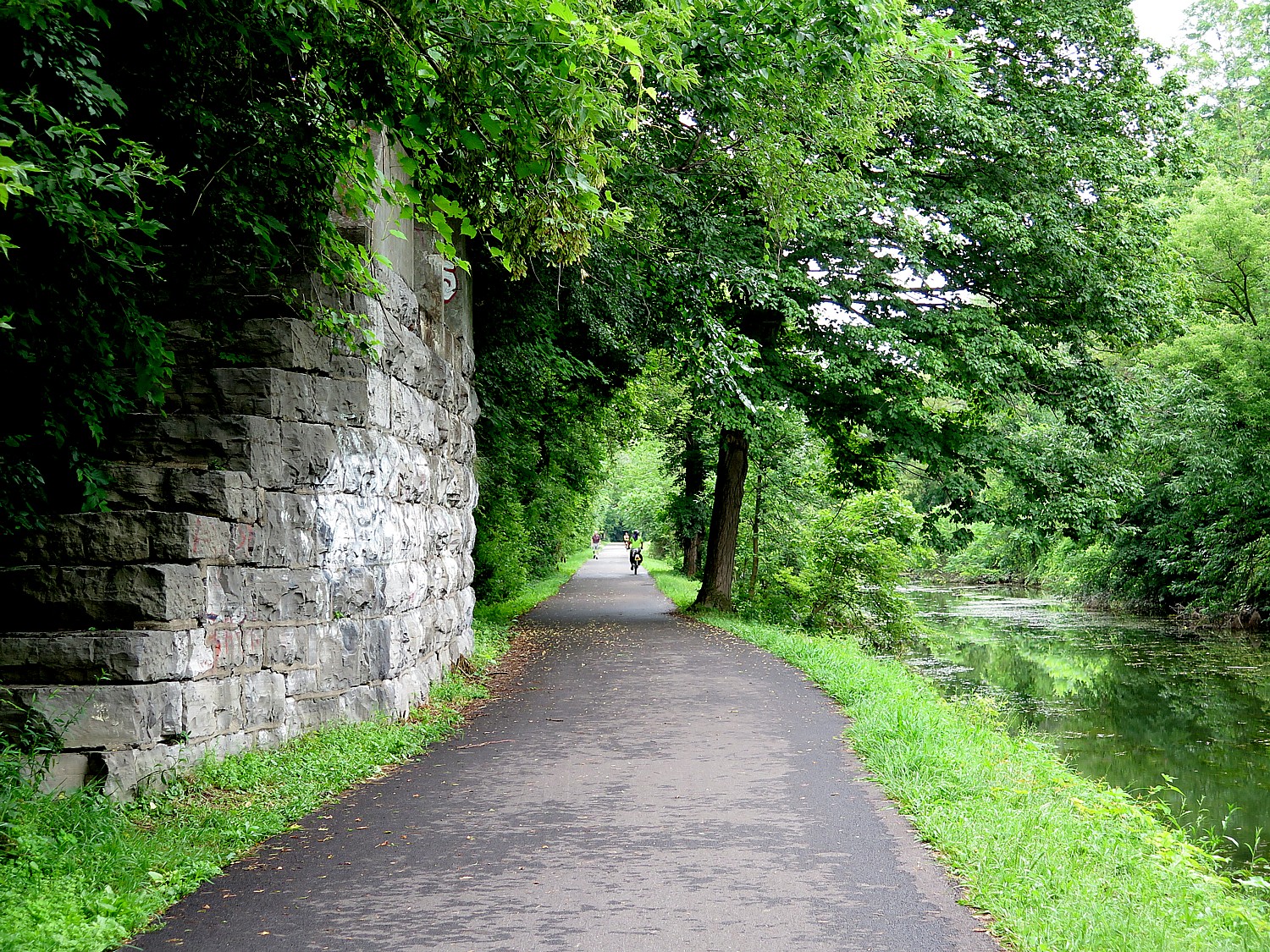
It is a drenching rain by the time I get to Canastota, where I remember there is a delightful Canal Town Museum which I visited on my first Cycle the Erie ride. Inside, I find other Erie Canal cyclists huddled together in the back, happily watching a video while they get warm.
Housed in a former bakery and residence dating from 1873, Canastota Canal Town Museum is a major surprise. From the outside, you wouldn’t think much at all of the tiny frame structure, but once inside, it’s like a Harry Potter experience – the rooms are chockablock full of fascinating artifacts and portraits that make the inside seem enormous. It is a surprisingly fine museum, which adds pieces of understanding to the historic puzzle of the Erie Canal and the rise of the United States. Here the focus is on people – including important people who contributed to building the canal, like Nathan Roberts (a Canastota native who devised the ingenious “Flight of Five” Locks in Lockport which we saw on our first day of the ride); there is a portrait of him by an important 19th century artist, Frederick R. Spencer, and portraits of others who owned the very existence of their town to the canal.

In addition to the ingenious engineering of Nathan Roberts’ lock system, I realize an amazing array of inventions came out of this tiny village: it was the birthplace of the American Microscope Industry; early movie and projection film industry.
I spot a photo on the wall referring to a action-adventure-comedy, “The Great Race” (1965), and only in that moment realize the movie was based on an actual event: the 1908 automobile race from New York to Paris, by way of Albany, Chicago, San Francisco, Seattle, Valdez Alaska, Japan, Vladivostok, Omsk, Moscow, St. Petersburg, Berlin and finally Paris. I learn that it was only made possible because of an innovation by Weed Chains of Canastota that enabled a car to drive across frozen Siberia. The 1908 Race was won by the American Thomas Flyer driven by George Schuster Sr. of Buffalo, NY. There is even a connection between Amelia Earhart and Canastota’s Airport opening in 1928. I am dazzled.
(Canastota Canal Town Museum, 122 Canal St., Canastota, NY 13032, 315-697-5002, www.canastota-canal.com)

Of the 50 miles between Syracuse and Rome that we ride today, 36 miles are in the Old Erie Canal New York State Park – rural, quaint, with wildlife, five aqueducts, and very flat. This is where the Erie Canal building began, in the “Long Level”. And just outside of our destination for today’s ride, Fort Stanwix in the center of Rome, we come to the historic marker where the very first shovel to dig the canal went into the ground on July 4, 1817.
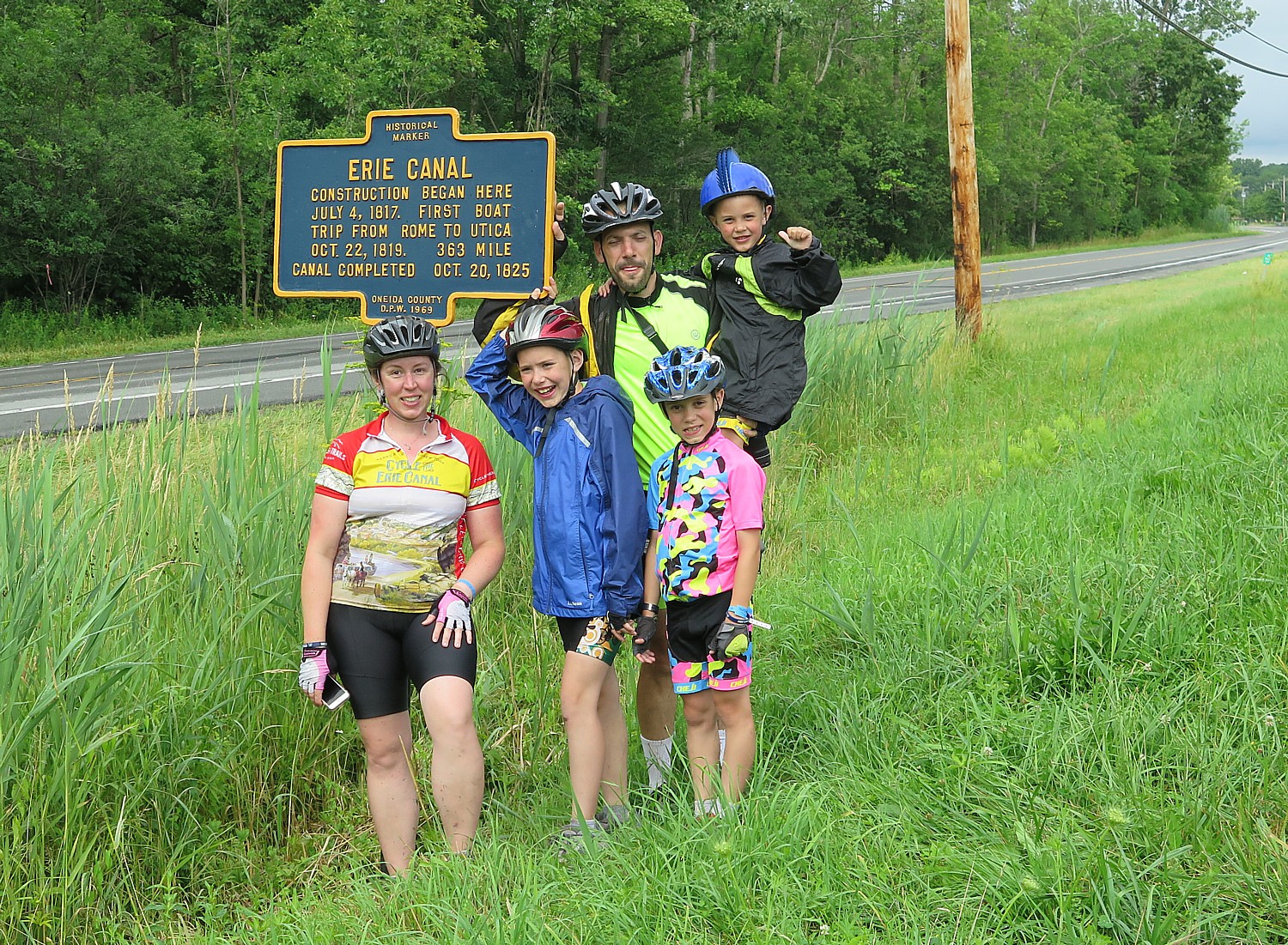
Mercifully, just as I ride into Rome, the rain stops, and I am able to set up my tent right outside Fort Stanwix, take a shower at the shower truck, change into dry clothes, and rush over to the Fort where they have arranged for guided tours (by costumed rangers) until 9 pm. I am literally the last one out of the Fort at closing. I walk a couple of blocks to a pizza shop for dinner (this is one of two nights that we are on our own for dinner). The National Park Rangers keep the Visitor Center open for us all night long, and I love to really linger over the exhibits.

The 20th Annual Cycle the Erie Canal ride is scheduled July 8 – 15, 2018 (www.ptny.org/canaltour). In the meantime, you can cycle the trail on your own – detailed info and interactive map is at the ptny.org site (www.ptny.org/bikecanal), including suggested lodgings. For more information on Cycle the Erie Canal, contact Parks & Trails New York at 518-434-1583 or visit www.ptny.org.
The entire Erie Canal corridor has been designated the Erie Canalway National Heritage Corridor, Waterford, NY 12188, 518-237-7000, www.eriecanalway.org.
More information about traveling on the Erie Canal is available from New York State Canal Corporation, www.canals.ny.gov.
Next: Cycle the Erie: At Fort Stanwix, Time Travel Back to America’s Colonial, Native American Past
See also:
Cycle the Erie: 400 Miles & 400 Years of History Flow By on Canalway Bike Tour Across New York State
Cycle the Erie, Day 4: Seneca Falls to Syracuse, Crossing Halfway Mark of 400-Mile Biketour
_____________________________
© 2018 Travel Features Syndicate, a division of Workstyles, Inc. All rights reserved. Visit goingplacesfarandnear.com, www.huffingtonpost.com/author/karen-rubin , and travelwritersmagazine.com/TravelFeaturesSyndicate/. Blogging at goingplacesnearandfar.wordpress.com and moralcompasstravel.info. Send comments or questions to [email protected]. Tweet @TravelFeatures. ‘Like’ us at facebook.com/NewsPhotoFeatures

6 thoughts on “Cycle the Erie, Day 5: Deep Dive into The Erie Canal: ‘Mother of Cities’, Empire Builder, Wonder of the World”
Comments are closed.